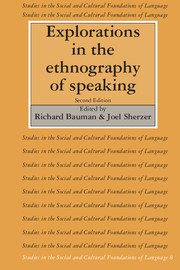Book contents
- Frontmatter
- Contents
- INTRODUCTION TO THE SECOND EDITION
- I PREFACE AND INTRODUCTION
- II COMMUNITIES AND RESOURCES FOR PERFORMANCE
- Introduction
- 1 A Quantitative Paradigm for the Study of Communicative Competence
- 2 Language Identity of the Colombian Vaupés Indians
- 3 ‘Our Ancestors Spoke in Pairs’: Rotinese Views of Language, Dialect, and Code
- III COMMUNITY GROUND RULES FOR PERFORMANCE
- IV SPEECH ACTS, EVENTS, AND SITUATIONS
- V THE SHAPING OF ARTISTIC STRUCTURES IN PERFORMANCE
- VI TOWARD AN ETHNOLOGY OF SPEAKING
- Notes
- References
- Index of names
1 - A Quantitative Paradigm for the Study of Communicative Competence
Published online by Cambridge University Press: 05 June 2012
- Frontmatter
- Contents
- INTRODUCTION TO THE SECOND EDITION
- I PREFACE AND INTRODUCTION
- II COMMUNITIES AND RESOURCES FOR PERFORMANCE
- Introduction
- 1 A Quantitative Paradigm for the Study of Communicative Competence
- 2 Language Identity of the Colombian Vaupés Indians
- 3 ‘Our Ancestors Spoke in Pairs’: Rotinese Views of Language, Dialect, and Code
- III COMMUNITY GROUND RULES FOR PERFORMANCE
- IV SPEECH ACTS, EVENTS, AND SITUATIONS
- V THE SHAPING OF ARTISTIC STRUCTURES IN PERFORMANCE
- VI TOWARD AN ETHNOLOGY OF SPEAKING
- Notes
- References
- Index of names
Summary
The past decade has seen a great increase in scholarly efforts directed to exploring the systematicity of the relationships between sociocultural organization and language use. A basic assumption behind this search has been that speakers functioning as members of a particular society in terms of a particular culture have internalized not only rules of grammar, but also rules of appropriate speech usage which are broadly shared by other members of their society, and which they apply in their speech behaviour. Thus competence has been extended from the notion of the mastery of a set of grammatical rules to the mastery of a set of cultural rules which include the appropriate ways to apply grammatical rules in all speech situations possible for that society (Hymes 1972b). The notion of context has been extended to apply not only to linguistic context or environment, but to the social-situational circumstances of the speech event, even to the intent or ends of the speaker.
Many important concepts were developed during the 1960s for dealing with systematic sociolinguistic variability, as it came to be generally recognized that no community or individual is limited to a single variety of code (Hymes 1967). Such concepts include the idea of a linguistic repertoire (Gumperz 1964, 1965, 1968) of a community or of an individual, the code matrix of a community, consisting of all of its codes and subcodes, including languages, dialects, styles (Gumperz 1962), or registers (Halliday 1964) in their functional relationships; the idea that speech events can be characterized in terms of a set of components, such as channel, setting, participants, etc. (see Ervin-Tripp 1972; Hymes 1967, 1972a), each of which may be factored into a number of relevant features.
- Type
- Chapter
- Information
- Explorations in the Ethnography of Speaking , pp. 18 - 49Publisher: Cambridge University PressPrint publication year: 1989
- 3
- Cited by



